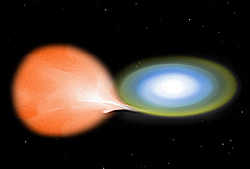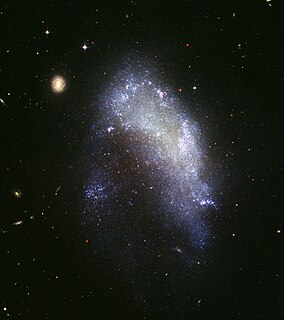
Hamsters are rodents belonging to the subfamily Cricetinae, which contains 19 species classified in seven genera. They have become established as popular small pets. The best-known species of hamster is the golden or Syrian hamster, which is the type most commonly kept as pets. Other hamster species commonly kept as pets are the three species of dwarf hamster, Campbell's dwarf hamster, the winter white dwarf hamster and the Roborovski hamster.

A nova is a transient astronomical event that causes the sudden appearance of a bright, apparently "new" star, that slowly fades over several weeks or many months. Causes of the dramatic appearance of a nova vary, depending on the circumstances of the two progenitor stars. All observed novae involve a white dwarf in a close binary system. The main sub-classes of novae are classical novae, recurrent novae (RNe), and dwarf novae. They are all considered to be cataclysmic variable stars.

Red Dwarf is a British science fiction comedy franchise created by Rob Grant and Doug Naylor which primarily consists of a television sitcom that aired on BBC Two between 1988 and 1999, and on Dave since 2009, gaining a cult following. The premise of the series follows the low-ranking technician Dave Lister, who awakens after being in suspended animation for three million years to find he is the last living human, with no crew on board the mining spacecraft Red Dwarf other than Arnold Rimmer, a hologram of Lister's deceased bunkmate, and Cat, a life form which evolved from Lister's pregnant cat.

In astronomy, stellar classification is the classification of stars based on their spectral characteristics. Electromagnetic radiation from the star is analyzed by splitting it with a prism or diffraction grating into a spectrum exhibiting the rainbow of colors interspersed with spectral lines. Each line indicates a particular chemical element or molecule, with the line strength indicating the abundance of that element. The strengths of the different spectral lines vary mainly due to the temperature of the photosphere, although in some cases there are true abundance differences. The spectral class of a star is a short code primarily summarizing the ionization state, giving an objective measure of the photosphere's temperature.

A brown dwarf is a type of substellar object that has a mass between the most massive gas giant planets and the least massive stars, approximately 13 to 80 times that of Jupiter (MJ).

A red dwarf is the smallest and coolest kind of star on the main sequence. Red dwarfs are by far the most common type of star in the Milky Way, at least in the neighborhood of the Sun, but because of their low luminosity, individual red dwarfs cannot be easily observed. From Earth, not one star that fits the stricter definitions of a red dwarf is visible to the naked eye. Proxima Centauri, the nearest star to the Sun, is a red dwarf, as are fifty of the sixty nearest stars. According to some estimates, red dwarfs make up three-quarters of the stars in the Milky Way.

An irregular galaxy is a galaxy that does not have a distinct regular shape, unlike a spiral or an elliptical galaxy. Irregular galaxies do not fall into any of the regular classes of the Hubble sequence, and they are often chaotic in appearance, with neither a nuclear bulge nor any trace of spiral arm structure.

A G-type main-sequence star, often called a yellow dwarf, or G dwarf star, is a main-sequence star of spectral type G. Such a star has about 0.84 to 1.15 solar masses and surface temperature of between 5,300 and 6,000 K., Tables VII, VIII. Like other main-sequence stars, a G-type main-sequence star is converting the element hydrogen to helium in its core by means of nuclear fusion. The Sun, the star to which the Earth is gravitationally bound in the Solar System, is an example of a G-type main-sequence star. Each second, the Sun fuses approximately 600 million tons of hydrogen into helium in a process known as the proton-proton chain, converting about 4 million tons of matter to energy. Besides the Sun, other well-known examples of G-type main-sequence stars include Alpha Centauri A, Tau Ceti, and 51 Pegasi.

A dwarf galaxy is a small galaxy composed of about 1000 up to several billion stars, as compared to the Milky Way's 200–400 billion stars. The Large Magellanic Cloud, which closely orbits the Milky Way and contains over 30 billion stars, is sometimes classified as a dwarf galaxy; others consider it a full-fledged galaxy. Dwarf galaxies' formation and activity are thought to be heavily influenced by interactions with larger galaxies. Astronomers identify numerous types of dwarf galaxies, based on their shape and composition.

V838 Herculis, also known as Nova Herculis 1991, was a nova which occurred in the constellation Hercules in 1991. It was discovered by George Alcock of Yaxley, Cambridgeshire, England at 4:35 UT on the morning of 25 March 1991. He found it with 10×50 binoculars, and on that morning its apparent visual magnitude was 5. Palomar Sky Survey plates showed that before the outburst, the star was at photographic magnitude 20.6 and 18.25.

A satellite galaxy is a smaller companion galaxy that travels on bound orbits within the gravitational potential of a more massive and luminous host galaxy. Satellite galaxies and their constituents are bound to their host galaxy, in the same way that planets within our own solar system are gravitationally bound to the Sun. While most satellite galaxies are dwarf galaxies, satellite galaxies of large galaxy clusters can be much more massive. The Milky Way is orbited by about fifty satellite galaxies, the largest of which is the Large Magellanic Cloud.

The pygmy shark, the second-smallest of all the shark species after the dwarf lanternshark, is a squaliform shark of the family Dalatiidae, the only member of the genus Euprotomicrus. Their lengths are up to about 25 cm (10 in) for females and about 22 cm (8.7 in) for males.

Marvic Valentin Castelo Sotto Sr. is a Filipino actor, singer, and comedian, best known for his various television and film projects on the major Philippine television networks GMA, TV5, and ABS-CBN. He is one of three pioneer hosts of Eat Bulaga!, which is the longest-running Philippine noontime variety show.

Neotragus is a genus of dwarf antelope, native to Africa. The genus includes only a single species without any dispute, namely Neotragus pygmaeus. Recent nucleic acid studies now suggest that the other two species formerly included in the genus are not closely related, and should be assigned to the genus Nesotragus.

Snow White is a fictional character and a main character from Walt Disney Productions' first animated feature film Snow White and the Seven Dwarfs (1937). The character of Snow White was derived from a fairy tale known from many countries in Europe, the best-known version being the one collected by the Brothers Grimm.

Paloma Faith Blomfield is an English singer, songwriter and actress. She is known for her retro and eccentric style. Her debut album Do You Want the Truth or Something Beautiful? was released in 2009 and has been certified double platinum in the UK. The album contains the singles "Stone Cold Sober", "New York", and "Upside Down", and earned Faith her first BRIT Award nomination in 2010.

The paloma is a tequila-based cocktail. This drink is most commonly prepared by mixing tequila, lime juice, and a grapefruit-flavored soda such as Fresca, Squirt, or Jarritos and served on the rocks with a lime wedge. Adding salt to the rim of the glass is also an option.

"Only Love Can Hurt Like This" is a song by English singer Paloma Faith, written by Diane Warren. Released as the second single to promote her third studio album, A Perfect Contradiction (2014), on 11 May 2014, it was promoted on shows such as Alan Carr: Chatty Man.

Infinite Things is the fifth studio album by British singer Paloma Faith, released through Sony Music on 13 November 2020.


















